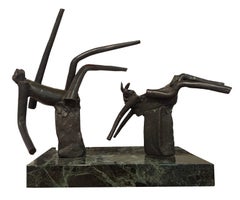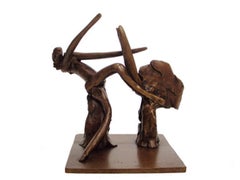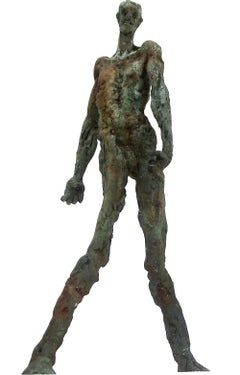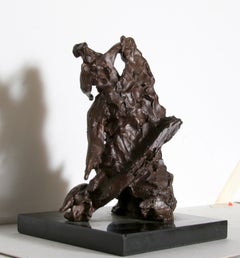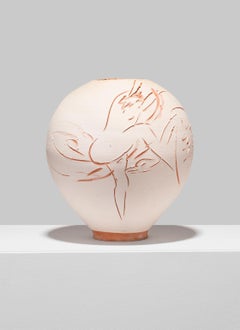Reuben Nakian Figurative Sculptures
to
2
1
Overall Width
to
Overall Height
to
3
2
1
2
1
2
1
1
1
1
3
3
1
1
28
125
107
100
88
3
Artist: Reuben Nakian
Leda and the Swan, Bronze Sculpture by Reuben Nakian
By Reuben Nakian
Located in Long Island City, NY
A bronze sculpture by Reuben Nakian from 1978. An abstract-figurative sculpture representing the Greek myth of Leda and the Swan- in which the Greek god Z...
Category
1970s Expressionist Reuben Nakian Figurative Sculptures
Materials
Bronze
"Nymph and Goat" Modern Abstract Mythological Bronze and Marble Sculpture
By Reuben Nakian
Located in Houston, TX
Modern abstract sculpture of a woman and goat by renowned artist Reuben Nakian. The work features a female nymph figure lying back as a goat figure approaches in Nakian's iconic bloc...
Category
1980s Abstract Reuben Nakian Figurative Sculptures
Materials
Granite, Bronze
Leda and the Swan, Ed. 1/9
By Reuben Nakian
Located in Greenwich, CT
Classical mythology is fraught with stories of sexual misdeeds by Zeus, King of the Gods. Often Zeus would fall in love with a mortal woman and then transform himself into an animal ...
Category
1970s Abstract Reuben Nakian Figurative Sculptures
Materials
Bronze
Related Items
Expressionist Bronze Sculpture with Paper Model Female Figures Beginning to Fly
By Óscar Aldonza Torres
Located in FISTERRA, ES
Expressionist bronze sculpture using a direct paper model technique, this work presents a group of female figures beginning to fly. Óscar Aldonza creates each figure from crushed and...
Category
2010s Expressionist Reuben Nakian Figurative Sculptures
Materials
Bronze
$1,705 Sale Price
20% Off
H 13.78 in W 7.88 in D 11.03 in
Expressionist Heavy Bronze Sculpture in Lost Wax Casting Containing the Rage
By Óscar Aldonza Torres
Located in FISTERRA, ES
Expressionist bronze sculpture in lost wax casting exploring contained emotion and inner tension. Containing the Rage is a unique figurative work by Galician sculptor Óscar Aldonza, ...
Category
2010s Expressionist Reuben Nakian Figurative Sculptures
Materials
Bronze
$2,368 Sale Price
20% Off
H 21.66 in W 11.03 in D 6.7 in
Anatomical 3/50 - smooth, black, granite, indoor/outdoor, figurative sculpture
By Jeremy Guy
Located in Bloomfield, ON
Smooth-surfaced, black granite has been engineered and sculpted into an elegant and classic depiction of a human figure by Jeremy Guy. The formalist play of positive and negative spa...
Category
2010s Abstract Reuben Nakian Figurative Sculptures
Materials
Stone, Granite
$15,500
H 48 in W 20 in D 12 in
Mujer Agachada (Crouching Woman), 1972, (III/VI)
By Felipe Castañeda
Located in San Francisco, CA
Felipe Castañeda
Mujer Agachada (Crouching Woman), 1972
Bronze, wood base
12 x 9.5 x 11.5 inches
Edition III/VI
Most recent owners acquired this limited-edition bronze sculpture fro...
Category
Late 20th Century Expressionist Reuben Nakian Figurative Sculptures
Materials
Bronze
$12,000 Sale Price
20% Off
H 12 in W 9.5 in D 11.5 in
Family IV - Elegant Figurative Bronze Sculpture of Two People
By Nando Kallweit
Located in Los Angeles, CA
German sculptor Nando Kallweit produces figurative bronze sculptures and reliefs with aquiline and a graceful modern appeal. Kallweit is inspired by seemingly disparate cultures; the strength of ancient Egyptian sculptures...
Category
21st Century and Contemporary Abstract Reuben Nakian Figurative Sculptures
Materials
Metal, Bronze
$2,000
H 12 in W 3 in D 3 in
Large Modernist Bronze Abstract Figural Sculpture "Family" Wolfgang Behl
Located in Surfside, FL
This is a mid 20th century mod abstract large bronze sculpture by Wolfgang Behl (German/American, 1918-1994).
The sculptural group titled "The Family" features a mother and father w...
Category
20th Century Expressionist Reuben Nakian Figurative Sculptures
Materials
Marble, Bronze
$3,000
H 21 in W 10.25 in D 10.25 in
German Expressionist Bronze Relief Plaque Mans Best Friend, a Man and His Dog
Located in Surfside, FL
Mans Best Friend
C.M. Junghans
1985
This is done in a German Expressionist style. It is bronze over some sort of fill. It depicts a man gentleman and his dog. a Cocker Spaniel or Co...
Category
20th Century Expressionist Reuben Nakian Figurative Sculptures
Materials
Bronze
$850
H 16 in W 10.5 in D 1.5 in
Solstice Dark Bronze Ed 1/12 - elegant, female, figurative, bronze sculpture
By Jeremy Guy
Located in Bloomfield, ON
At once both elegant and classic, this superb sculpture is the work of Jeremy Guy. The graceful form of a female figure emerges from the black granite. Guy has long been influenced ...
Category
2010s Contemporary Reuben Nakian Figurative Sculptures
Materials
Granite, Bronze
$12,000
H 31 in W 16 in D 7 in
Mexican indian woman with Water Pot (In the style of Francisco Zúñiga)
Located in Guadalajara, Jalisco
Mexican Indian Woman with Water Pot (In the style of Francisco Zúñiga)
Unknow Artis
Lost Wax Bronze
45 x 35 x 35 cm
1960, MX
No base
Category
1970s Expressionist Reuben Nakian Figurative Sculptures
Materials
Bronze
$2,800
H 17.72 in W 13.78 in D 13.78 in
Immigrant V3 - female, figurative, bronze, stainless steel outdoor sculpture
Located in Bloomfield, ON
This figurative outdoor sculpture in female form is forged in bronze and stainless steel.
Galina Stetco used her own body as a model for the mould of this compelling and poignant l...
Category
2010s Abstract Reuben Nakian Figurative Sculptures
Materials
Bronze
$52,000
H 73 in W 42 in D 36 in
Wind Girl II Medium
Located in Somerset West, WC
Wind Girl II medium is a limited edition bronze sculpture with a nickel plating.
Category
2010s Abstract Reuben Nakian Figurative Sculptures
Materials
Bronze
Large Bronze Bas Relief Danse Macabre Expressionist Sculpture Totentantz
Located in Surfside, FL
We have not located any markings on the piece and it does not appear to be signed. it bears similarities with works by Wilfredo Lam and other Cuban and Latin American masters and it ...
Category
Early 20th Century Expressionist Reuben Nakian Figurative Sculptures
Materials
Bronze
$4,500
H 18 in W 20.75 in D 4 in
Previously Available Items
Europa and the Bull
By Reuben Nakian
Located in Long Island City, NY
A bronze sculpture by Reuben Nakian from 1978. An abstract-figurative sculpture representing the Greek myth of Europa's Abduction - in which the Greek god Zeus, in the form of a white Bull, abducts and seduces Europa.
Artist: Reuben Nakian (American, 1897-1986)
Title: Europa and the Bull...
Category
1970s Abstract Reuben Nakian Figurative Sculptures
Materials
Bronze
"Leda and the Swan", Incised Earthenware Terracotta Vase, Signed
By Reuben Nakian
Located in Detroit, MI
"Leda and the Swan" is an earthenware terracotta vase incised by the acclaimed artist Reuben Nakian and made and glazed by his frequent collaborator James Jackson...
Category
1980s Abstract Expressionist Reuben Nakian Figurative Sculptures
Materials
Earthenware, Terracotta
H 13.5 in W 10.5 in D 10.5 in
Leda and the Swan, Bronze Sculpture by Reuben Nakian
By Reuben Nakian
Located in Long Island City, NY
A bronze sculpture by Reuben Nakian from 1978. An abstract-figurative sculpture representing the Greek myth of Leda and the Swan- in which the Greek god Zeus, in the form of a swan, ...
Category
1970s Expressionist Reuben Nakian Figurative Sculptures
Materials
Bronze
Voyage to Crete Plaque, Bronze Wall Sculpture
By Reuben Nakian
Located in Long Island City, NY
Artist: Reuben Nakian, American (1897 - 1986)
Title: Voyage to Crete Plaque
Year: 1968
Medium: Bronze Relief Sculpture, signature inscribed
Edition: 1/9
Size: 18 x 24 x 1.5 in...
Category
1960s American Modern Reuben Nakian Figurative Sculptures
Materials
Bronze
Reuben Nakian figurative sculptures for sale on 1stDibs.
Find a wide variety of authentic Reuben Nakian figurative sculptures available for sale on 1stDibs. You can also browse by medium to find art by Reuben Nakian in bronze, metal, granite and more. Much of the original work by this artist or collective was created during the 20th century and is mostly associated with the abstract style. Not every interior allows for large Reuben Nakian figurative sculptures, so small editions measuring 5 inches across are available. Customers who are interested in this artist might also find the work of David Adickes, Delphine Grandvaux, and Jeremy Guy. Reuben Nakian figurative sculptures prices can differ depending upon medium, time period and other attributes. On 1stDibs, the price for these items starts at $5,500 and tops out at $125,000, while the average work can sell for $12,500.
